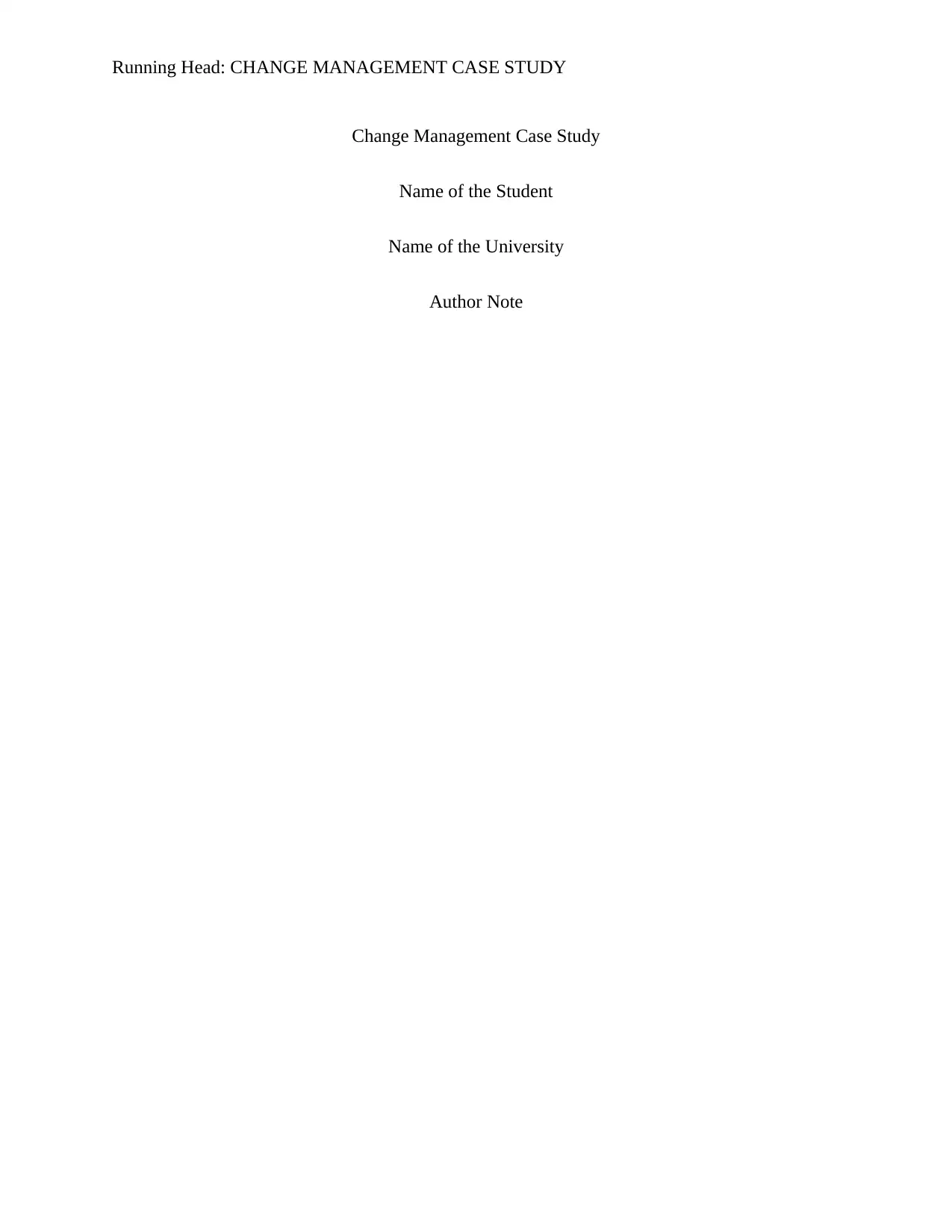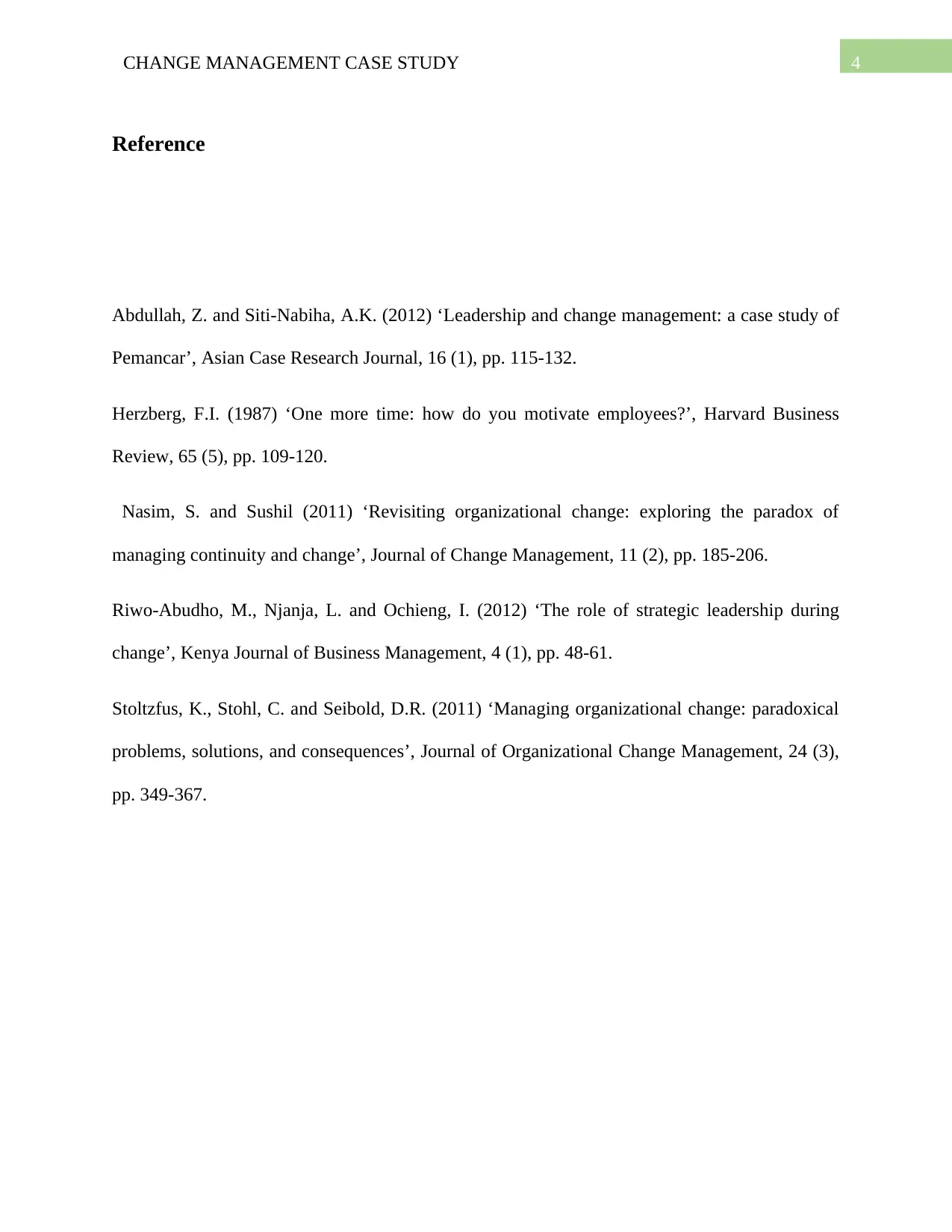Change Management Case Study
VerifiedAdded on 2023/04/23
|5
|946
|394
AI Summary
Read this case study on change management in Pemancar, an automotive parts manufacturing company in Malaysia. Learn about the challenges faced by the company and leadership techniques to manage change.
Contribute Materials
Your contribution can guide someone’s learning journey. Share your
documents today.

Running Head: CHANGE MANAGEMENT CASE STUDY
Change Management Case Study
Name of the Student
Name of the University
Author Note
Change Management Case Study
Name of the Student
Name of the University
Author Note
Secure Best Marks with AI Grader
Need help grading? Try our AI Grader for instant feedback on your assignments.

1CHANGE MANAGEMENT CASE STUDY
Pemancar case study Analysis
Abdullah and Siti-Nabiha (2012), suggest that change management is a systematic approach
which deals with the transformation in the organizational goals, technologies or the processes. In
the case study of Abdullah and Siti-Nabiha, the implementation of an advanced organizational
culture by a European –based multinational company on a Malaysia subsidiary has been
depicted. The case study of Pemacar displays the organizational resistance against shedding off
the prevailing organizational culture and adopting the new one. Pemancar is an automotive parts
manufacturing company which is located in Malysia.
The acquisition of the company by NOVA has imposed different air of operations in the
company lead by Danial Tareq. As per the parent company new product specifications were
added, new technology and new machinery and forced production standards and quality.
Notably, the new culture is focused toward increased accountability, high performance, value
creation and strong communication. The change in work culture initiated heightened stress in the
workforce. The existing pyramidal and bureaucratic type of structure in Pemancar was
substituted with a leaner and flatter structure to leverage better and effective communication in
the organization. As far as the theory of punctuated equilibrium is concerned, in Pemancar, the
current situation of stasis requires sudden punctuation with radical shifts to result in a suitable
change.
In the article of Nasim and Sushil (2011), change management has been seen from the
perspective of ‘paradox lens’ and elaborates a clear shift of approach to paradoxical thinking.
They suggest that managing change is equal to managing the paradoxes. While managing
change, the leaders or the organizations must balance the paradox of change and continuity
Pemancar case study Analysis
Abdullah and Siti-Nabiha (2012), suggest that change management is a systematic approach
which deals with the transformation in the organizational goals, technologies or the processes. In
the case study of Abdullah and Siti-Nabiha, the implementation of an advanced organizational
culture by a European –based multinational company on a Malaysia subsidiary has been
depicted. The case study of Pemacar displays the organizational resistance against shedding off
the prevailing organizational culture and adopting the new one. Pemancar is an automotive parts
manufacturing company which is located in Malysia.
The acquisition of the company by NOVA has imposed different air of operations in the
company lead by Danial Tareq. As per the parent company new product specifications were
added, new technology and new machinery and forced production standards and quality.
Notably, the new culture is focused toward increased accountability, high performance, value
creation and strong communication. The change in work culture initiated heightened stress in the
workforce. The existing pyramidal and bureaucratic type of structure in Pemancar was
substituted with a leaner and flatter structure to leverage better and effective communication in
the organization. As far as the theory of punctuated equilibrium is concerned, in Pemancar, the
current situation of stasis requires sudden punctuation with radical shifts to result in a suitable
change.
In the article of Nasim and Sushil (2011), change management has been seen from the
perspective of ‘paradox lens’ and elaborates a clear shift of approach to paradoxical thinking.
They suggest that managing change is equal to managing the paradoxes. While managing
change, the leaders or the organizations must balance the paradox of change and continuity

2CHANGE MANAGEMENT CASE STUDY
(Herzberg 1987). While implementing cultural change in Pemancar, Danial Tareq might face
conflicts such as:
Task conflict- It is one of the most important conflicts that is related to the assignments
of the employees. Dispute might arise regarding how the division of the resources should
be done (Riwo-Abudho, Njanja and Ochieng 2012). The difference of opinion on the
new policies and procedures also might arise. It might hinder the expectations at work,
interpretations of fact and judgements.
The personality conflict – It is another conflict that might arise from the differences in
personality, matters of taste, style and also the styles of conflict. It might have initiated
from the cultural difference between the Malaysia and Europe.
The value conflict – It is that kind of conflict that arises from the different types of values
and identities. In an organization, people belong from different ethics, politics, ethics and
deeply held beliefs.
Another difficulty might be faced regarding retaining the staffs. The changed culture and
environment of the organization can leave impact on the suppliers and the suppliers
which can in turn get reflected on the profitability of the organization (Herzberg 1987).
The unaccepted culture can also decline the quality or work and incur financial loss for
the company.
The leadership techniques of Daniel in managing the change should be focused on certain factors
for receiving better outcomes.
The management of change is a leadership challenge which should be addressed. Daniel
must have a visionary outlook in setting the high standards consistently (Stoltzfus, Stohl
and Seibold 2011). He must have a clear and concise communication with the employees.
(Herzberg 1987). While implementing cultural change in Pemancar, Danial Tareq might face
conflicts such as:
Task conflict- It is one of the most important conflicts that is related to the assignments
of the employees. Dispute might arise regarding how the division of the resources should
be done (Riwo-Abudho, Njanja and Ochieng 2012). The difference of opinion on the
new policies and procedures also might arise. It might hinder the expectations at work,
interpretations of fact and judgements.
The personality conflict – It is another conflict that might arise from the differences in
personality, matters of taste, style and also the styles of conflict. It might have initiated
from the cultural difference between the Malaysia and Europe.
The value conflict – It is that kind of conflict that arises from the different types of values
and identities. In an organization, people belong from different ethics, politics, ethics and
deeply held beliefs.
Another difficulty might be faced regarding retaining the staffs. The changed culture and
environment of the organization can leave impact on the suppliers and the suppliers
which can in turn get reflected on the profitability of the organization (Herzberg 1987).
The unaccepted culture can also decline the quality or work and incur financial loss for
the company.
The leadership techniques of Daniel in managing the change should be focused on certain factors
for receiving better outcomes.
The management of change is a leadership challenge which should be addressed. Daniel
must have a visionary outlook in setting the high standards consistently (Stoltzfus, Stohl
and Seibold 2011). He must have a clear and concise communication with the employees.

3CHANGE MANAGEMENT CASE STUDY
The strategy of ‘walking the talk’ is a good example along with having confidence in the
self and in others.
As Nasim and Sushil (2011) suggested, all types of difficulties must not necessarily end
up in intractable paradoxes and it is possible to search for solutions to provide what is
actually wanted.
The change management strategy should secure the level of stakeholder support required
to achieve a successful transition as mentioned by Nasim and Sushil (2011). The aim
should be to grow the interpersonal relationships with the people who are to be changed.
The strategy of ‘walking the talk’ is a good example along with having confidence in the
self and in others.
As Nasim and Sushil (2011) suggested, all types of difficulties must not necessarily end
up in intractable paradoxes and it is possible to search for solutions to provide what is
actually wanted.
The change management strategy should secure the level of stakeholder support required
to achieve a successful transition as mentioned by Nasim and Sushil (2011). The aim
should be to grow the interpersonal relationships with the people who are to be changed.
Secure Best Marks with AI Grader
Need help grading? Try our AI Grader for instant feedback on your assignments.

4CHANGE MANAGEMENT CASE STUDY
Reference
Abdullah, Z. and Siti-Nabiha, A.K. (2012) ‘Leadership and change management: a case study of
Pemancar’, Asian Case Research Journal, 16 (1), pp. 115-132.
Herzberg, F.I. (1987) ‘One more time: how do you motivate employees?’, Harvard Business
Review, 65 (5), pp. 109-120.
Nasim, S. and Sushil (2011) ‘Revisiting organizational change: exploring the paradox of
managing continuity and change’, Journal of Change Management, 11 (2), pp. 185-206.
Riwo-Abudho, M., Njanja, L. and Ochieng, I. (2012) ‘The role of strategic leadership during
change’, Kenya Journal of Business Management, 4 (1), pp. 48-61.
Stoltzfus, K., Stohl, C. and Seibold, D.R. (2011) ‘Managing organizational change: paradoxical
problems, solutions, and consequences’, Journal of Organizational Change Management, 24 (3),
pp. 349-367.
Reference
Abdullah, Z. and Siti-Nabiha, A.K. (2012) ‘Leadership and change management: a case study of
Pemancar’, Asian Case Research Journal, 16 (1), pp. 115-132.
Herzberg, F.I. (1987) ‘One more time: how do you motivate employees?’, Harvard Business
Review, 65 (5), pp. 109-120.
Nasim, S. and Sushil (2011) ‘Revisiting organizational change: exploring the paradox of
managing continuity and change’, Journal of Change Management, 11 (2), pp. 185-206.
Riwo-Abudho, M., Njanja, L. and Ochieng, I. (2012) ‘The role of strategic leadership during
change’, Kenya Journal of Business Management, 4 (1), pp. 48-61.
Stoltzfus, K., Stohl, C. and Seibold, D.R. (2011) ‘Managing organizational change: paradoxical
problems, solutions, and consequences’, Journal of Organizational Change Management, 24 (3),
pp. 349-367.
1 out of 5
Related Documents
Your All-in-One AI-Powered Toolkit for Academic Success.
+13062052269
info@desklib.com
Available 24*7 on WhatsApp / Email
![[object Object]](/_next/static/media/star-bottom.7253800d.svg)
Unlock your academic potential
© 2024 | Zucol Services PVT LTD | All rights reserved.





